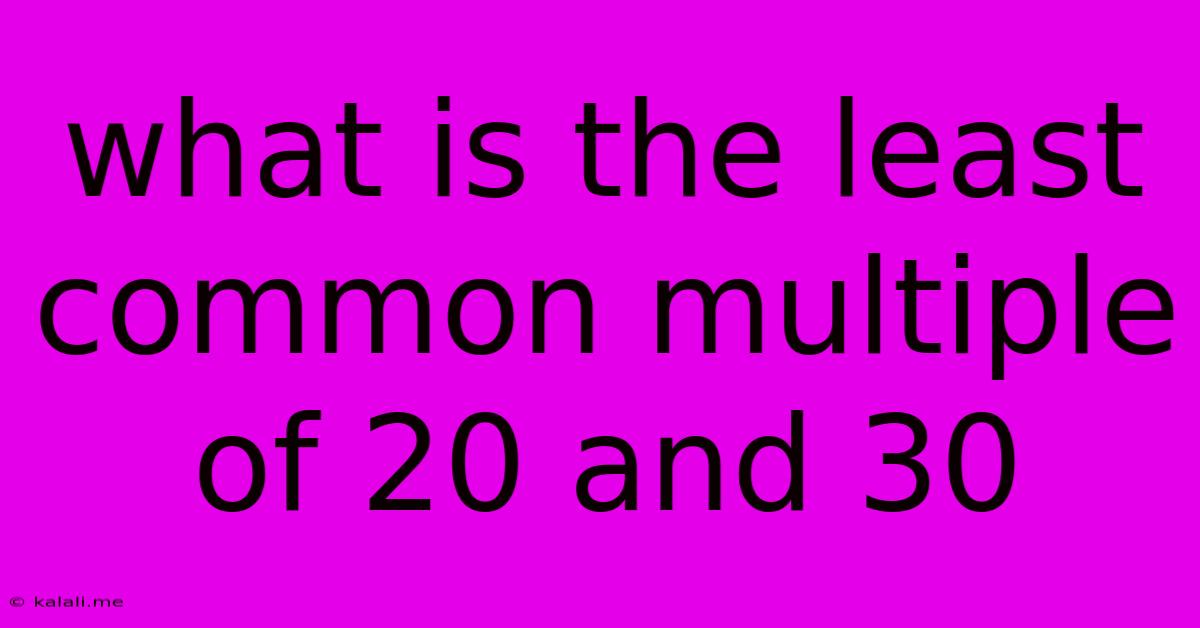What Is The Least Common Multiple Of 20 And 30
Kalali
May 09, 2025 · 3 min read

Table of Contents
What is the Least Common Multiple (LCM) of 20 and 30? A Comprehensive Guide
Finding the least common multiple (LCM) of two numbers is a fundamental concept in mathematics with applications ranging from simple arithmetic to complex algebraic problems. This article will clearly explain how to calculate the LCM of 20 and 30, using several methods, and will also delve into the underlying concepts to solidify your understanding. This guide is perfect for students, teachers, or anyone looking to refresh their knowledge of LCMs.
What is the Least Common Multiple (LCM)?
The least common multiple (LCM) of two or more integers is the smallest positive integer that is divisible by all the integers. In simpler terms, it's the smallest number that is a multiple of both (or all) the given numbers. Understanding LCM is crucial for solving problems related to fractions, time calculations, and more.
Methods to Find the LCM of 20 and 30
We'll explore three common methods to determine the LCM of 20 and 30:
1. Listing Multiples Method
This method involves listing the multiples of each number until you find the smallest multiple common to both.
- Multiples of 20: 20, 40, 60, 80, 100, 120...
- Multiples of 30: 30, 60, 90, 120, 150...
As you can see, the smallest multiple that appears in both lists is 60. Therefore, the LCM of 20 and 30 is 60. While simple for smaller numbers, this method becomes less efficient for larger numbers.
2. Prime Factorization Method
This is a more efficient method, especially for larger numbers. It involves finding the prime factorization of each number and then constructing the LCM using the highest powers of each prime factor.
- Prime factorization of 20: 2² x 5
- Prime factorization of 30: 2 x 3 x 5
To find the LCM, we take the highest power of each prime factor present in either factorization:
- Highest power of 2: 2² = 4
- Highest power of 3: 3¹ = 3
- Highest power of 5: 5¹ = 5
Multiply these together: 4 x 3 x 5 = 60. Therefore, the LCM of 20 and 30 is 60.
3. Greatest Common Divisor (GCD) Method
This method utilizes the relationship between the LCM and the greatest common divisor (GCD) of two numbers. The formula is:
LCM(a, b) = (|a x b|) / GCD(a, b)
First, we need to find the GCD of 20 and 30. The GCD is the largest number that divides both 20 and 30 without leaving a remainder. Using the Euclidean algorithm or prime factorization, we find that the GCD(20, 30) = 10.
Now, we can apply the formula:
LCM(20, 30) = (20 x 30) / 10 = 600 / 10 = 60
Therefore, the LCM of 20 and 30 is again 60.
Conclusion
We've demonstrated three different methods to calculate the least common multiple of 20 and 30, all arriving at the same answer: 60. The prime factorization method is generally preferred for its efficiency, especially when dealing with larger numbers or finding the LCM of more than two numbers. Understanding these methods provides a solid foundation for tackling more complex mathematical problems involving multiples and divisors.
Latest Posts
Latest Posts
-
What Is Half Of 1 4 Teaspoon
Jul 02, 2025
-
How Many Cups In A Pound Of Hamburger Meat
Jul 02, 2025
-
Imagery Or Figurative Language From Romeo And Juliet
Jul 02, 2025
-
What Is A Quarter Of A Million
Jul 02, 2025
-
Which Of The Following Is True Concerning A Dao
Jul 02, 2025
Related Post
Thank you for visiting our website which covers about What Is The Least Common Multiple Of 20 And 30 . We hope the information provided has been useful to you. Feel free to contact us if you have any questions or need further assistance. See you next time and don't miss to bookmark.